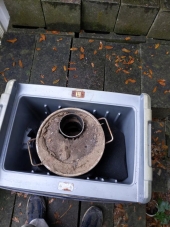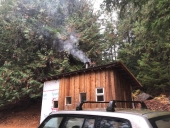
 1
1




Life on a farm is a school of patience; you can't hurry the crops or make an ox in two days.
Henri Alain
 4
4








Mike Lang wrote:My gut feeling is that this idea will introduce too much thermal mass into the riser, and will suck too much heat out of the flame.
Paul Wheaton uses ceramic fibre in his risers because is has a very low thermal mass and high heat tolerance.




Life on a farm is a school of patience; you can't hurry the crops or make an ox in two days.
Henri Alain




 1
1




Jason Broom wrote:If your riser is the size and weight of a 55-gallon drum, filled almost entirely with sand, how big would your radiator and manifold need to be? If I'm understanding your premise correctly, you would be building on a much larger scale, but still only have a 6" diameter system.
Life on a farm is a school of patience; you can't hurry the crops or make an ox in two days.
Henri Alain




 1
1




Life on a farm is a school of patience; you can't hurry the crops or make an ox in two days.
Henri Alain




 2
2













Glenn Herbert wrote:Billions of possibilities... and most of them will work worse than the standard designs. Not to discourage experimentation, but I think it would be productive to understand some of the fundamental parameters for design and materials, and not violate those, as doing so would definitely not be an improvement. Things like high mass risers fall under that category. We know that, all else constant, a low mass, insulative riser will work much better than a high mass, not very insulative riser. (Sand is too insulating to make a good heat exchange mass, but too dense and conductive to make a good insulator.)
I think it is a fundamental practice in experimenting to fully understand the characteristics of the standard before trying variations. Have you built a dead standard J-tube core for a baseline?

Life on a farm is a school of patience; you can't hurry the crops or make an ox in two days.
Henri Alain
 1
1









Jason Broom wrote:When I was about 8 years old, I am told I went to my mother and said to her, "There's two ways to learn something; by making your own mistakes or by learning from the mistakes other people make. I'm going to try to learn from other peoples' mistakes."
The last book you purchased, and flipped through, is the one to read. Ernie has made ALL of the mistakes, and learned the most from them, in my estimation. Erica articulates the lessons learned from those mistakes in a very effective manner. Their approach is logical, pragmatic and easily understood, making their book the de facto standard, at the moment. Others have made huge contributions; Donkey from proboards, Broaudio on Youtube, and Peter Vandenberg, at many different levels. These folks have collaborated and collated their knowledge at Paul Wheaton's gatherings.
All of this to say: The knowledge of how best to build a rocket stove (for cooking) or a rocket mass heater (for heating) is already well-established. Any prototype you are likely to undertake has already been done, found to be lacking in some way, and/or improved to the point where it is now part of the commonly accepted design concepts around these devices. It is frequently suggested that folks who are new to these concepts build a rocket stove or RMH "by the book" before venturing into new ideas. That is so you better understand how and why these devices work by learning from others.
Or, you can revel in the fact that we live in a free country, with an embarrassment of riches, where you are at liberty to make all of the mistakes yourself, and learn from them to your own edification.
Life on a farm is a school of patience; you can't hurry the crops or make an ox in two days.
Henri Alain




William Bronson wrote:Exploring possibilities on paper or pixels seems like a 100% good to me.
I have built a TLUD, bucket rocket, pocket rocket, batch rocket, and a J, none of them to specifications, all of them as a riff on the "right " way to build.
I read and asked questions about the device involved, and made the adjustments that made sense to me.
Stainless steel stock pot for the body of the TLUD.
Calcium aluminate cement for the casting of the bucket rocket.
Slab built the walls and floor of the batch box.
Water jacket for the feed of the J.
No regrets.
Works for me.
I made two pound cakes recipe for the first time the other night.
Baked them in two different ovens, and i substituted 1/4 of the flower by weight for cocoa.
They were a little dry buyut still tasty.
I had never made this recipe before.
I will never make it that same way again.
Bog standard design does not move me.
No regrets here.
I not sure about if this is what Mart intended , but for me this thread was an invitation to riff on cheaper, lower tech ways to achieve decent results.
I am glad others before us strayed from the beaten path, or we would have no established designs to stray from.
The very idea that a J is place to start from is doubtful to me.
A batch box is more stable at smaller sizes.
A bell offers lower resistance to flow than a bench.
45 minute burn times makes it easier to tend.
8 and 10 inch batch rockets burn longer pieces of wood than the equivalent sized J's, with no chance of reversing draft.
Shorter risers make for lower cooking surfaces.
But advocates for the J point out how cheap and simple building one is.
No need for a door, or carefully measured burn chambers.
Simpler to operate.
Just bricks, barrels, mud , sand straw, barrel , and ducts.
Why don't they all use ceramic fiber insulation?
It is clearly superior to any other matirials, unless you consider other things, like, health risks , availability or costs.
Life on a farm is a school of patience; you can't hurry the crops or make an ox in two days.
Henri Alain
 1
1




Country oriented nerd with primary interests in alternate energy in particular solar. Dabble in gardening, trees, cob, soil building and a host of others.













Glenn Herbert wrote:A few reasons to use a J-tube instead of an L-tube for an indoor RMH:
The extra 90 degree bend in the J introduces turbulence which helps mixing.
The vertical J feed is self-feeding as the fuel burns at the bottom, while the L needs to be fed manually as the wood burns.
The J has been measured to typically have more efficient combustion than the L.
The J is more resistant to sparks flying out and possibly landing on the floor.
The J is easy to cover with a couple of bricks to fine-tune the air supply.
The J is more convenient to feed and inspect, if the openings of both are at the same low-ish height off the floor.
On the other hand, the L can have a longer feed chamber and burn more wood at once.
You can even feed very long logs or sticks into the L, which is not generally safe to do with a J. These characteristics are conducive to use in high heat quantity applications like kilns or maple syrup evaporators.
On another point, the heat riser does not actually get any amount of abrasion, and soft materials like insulating firebrick or ceramic fiber blanket have held up well, and given the very highest performance. The burn tunnel does get some abrasion, and the feed tube can get a lot of abrasion depending on use, so strong materials there are important.
Life on a farm is a school of patience; you can't hurry the crops or make an ox in two days.
Henri Alain

|
It was a ray gun. And now this tiny ad insists on being addressed as "Ray":
The new kickstarter is now live!
https://www.kickstarter.com/projects/paulwheaton/garden-cards
|







